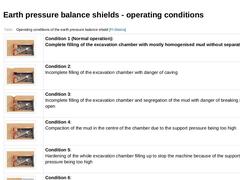
|

(Table: Operating conditions of the earth pressure balance shield [FI-Steina]) |
|
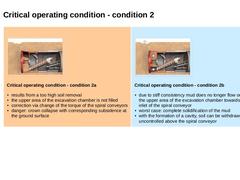
|

| (Image: EPB shield with incomplete filling of the working chamber with danger of caving (Condition 2a) with reference to [Wilms95] [Image: S&P GmbH]) Critical operating condition - condition 2a - results from a too high soil removal
- the upper area of the excavation chamber is not filled
- correction via change of the torque of the spiral conveyors
- danger: crown collapse with corresponding subsidence at the ground surface
| (Image: EPB shield with hardened material … |
|
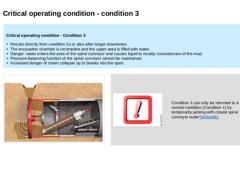
|

Critical operating condition - Condition 3 -
Results directly from condition 2a or also after longer downtimes.
-
The excavation chamber is incomplete and the upper area is filled with water.
-
Danger: water enters the area of the spiral conveyor and causes liquid to muddy consistencies of the mud.
-
Pressure-balancing function of the spiral conveyor cannot be maintained.
-
Increased danger of crown collapse up to breaks into the open.
|
|
|
|
(Image: EPB … |
|
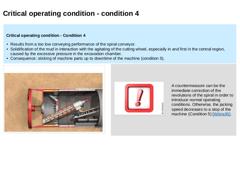
|

Critical operating condition - Condition 4 -
Results from a too low conveying performance of the spiral conveyor.
-
Solidification of the mud in interaction with the agitating of the cutting wheel, especially in and first in the central region, caused by the excessive pressure in the excavation chamber.
-
Consequence: sticking of machine parts up to downtime of the machine (condition 5).
|
|
(Image: EPB shield with compaction of the mud in the excavation … |
|
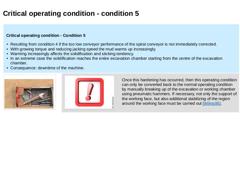
|

Critical operating condition - Condition 5 -
Resulting from condition 4 if the too low conveyor performance of the spiral conveyor is not immediately corrected.
-
With growing torque and reducing jacking speed the mud warms up increasingly.
-
Warming increasingly affects the solidification and sticking tendency.
-
In an extreme case the solidification reaches the entire excavation chamber starting from the centre of the excavation chamber.
-
Consequence: …
|
|
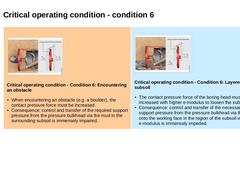
|

| (Image: Operating condition when encountering an obstacle (Condition 6) with reference to [Maidl97b] [Image: S&P GmbH]) Critical operating condition - Condition 6: Encountering an obstacle - When encountering an obstacle (e.g. a boulder), the contact pressure force must be increased.
- Consequence: control and transfer of the required support pressure from the pressure bulkhead via the mud in the surrounding subsoil is immensely impaired.
| (Image: EPB shield … |
|
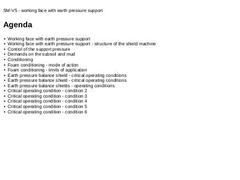
|

|
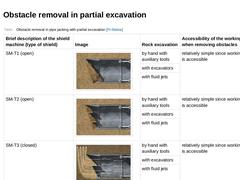
|

(Table: Obstacle removal in pipe jacking with partial excavation [FI-Steina]) |
|
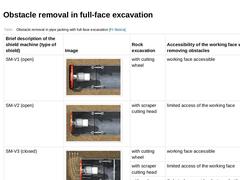
|

(Table: Obstacle removal in pipe jacking with full-face excavation [FI-Steina]) |
|

|

|
(Table: Obstacle removal in pipe jacking (special forms)) |
|

|

|
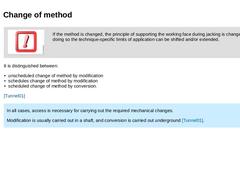
|

|
(Image: Attention!)
If the method is changed, the principle of supporting the working face during jacking is changed. By doing so the technique-specific limits of application can be shifted and/or extended. |
|
It is distinguished between: -
unscheduled change of method by modification
-
schedules change of method by modification
-
scheduled change of method by conversion.
[Tunnel01] |
|
In all cases, access is necessary for carrying out the required mechanical … |
|
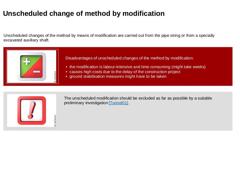
|

Unscheduled changes of the method by means of modification are carried out from the pipe string or from a specially excavated auxiliary shaft. |
|
(Image: Pros and cons) |
Disadvantages of unscheduled changes of the method by modification: -
the modification is labour-intensive and time-consuming (might take weeks)
-
causes high costs due to the delay of the construction project
-
ground stabilisation measures might have to be taken
|
|
|
|
|
(Image: Attention!) |
|
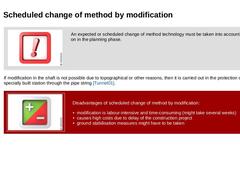
|

| (Image: Attention!) An expected or scheduled change of method technology must be taken into account early on in the planning phase. | | If modification in the shaft is not possible due to topographical or other reasons, then it is carried out in the protection of a specially built station through the pipe string [Tunnel01]. | | (Image: Pros and cons) | Disadvantages of scheduled change of method by modification: - modification is labour-intensive and time-…
|
|
|
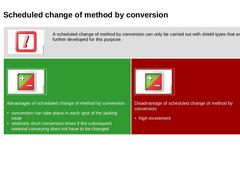
|

|
(Image: Attention!)
A scheduled change of method by conversion can only be carried out with shield types that are further developed for this purpose. |
|
(Image: Pros and cons)
Advantages of scheduled change of method by conversion: -
conversion can take place in each spot of the jacking route
-
relatively short conversion times if the subsequent material conveying does not have to be changed
|
(Image: Pros and cons)
Disadvantage of scheduled change of … |
|
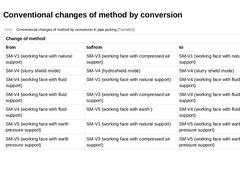
|

(Table: Conventional changes of method by conversion in pipe jacking [Tunnel01]) |
|

|

|
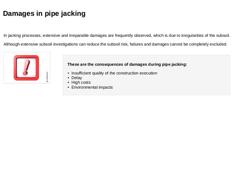
|

In jacking processes, extensive and irreparable damages are frequently observed, which is due to irregularities of the subsoil. Although extensive subsoil investigations can reduce the subsoil risk, failures and damages cannot be completely excluded. These are the consequences of damages during pipe jacking: -
Insufficient quality of the construction execution
-
Delay
-
High costs
-
Environmental impacts
|
|
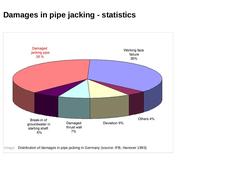
|

(Image: Distribution of damages in pipe jacking in Germany (source: IFB, Hanover 1993)) |
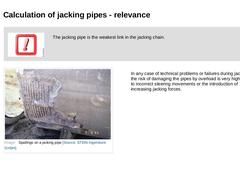
|

|
(Image: Attention!)
The jacking pipe is the weakest link in the jacking chain. |
(Image: Spallings on a jacking pipe) In any case of technical problems or failures during jacking, the risk of damaging the pipes by overload is very high due to incorrect steering movements or the introduction of increasing jacking forces. |
|
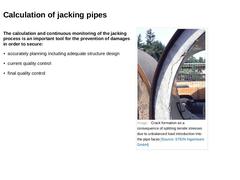
|

The calculation and continuous monitoring of the jacking process is an important tool for the prevention of damages in order to secure: (Image: Crack formation as a consequence of splitting tensile stresses due to unbalanced load introduction into the pipe faces) |
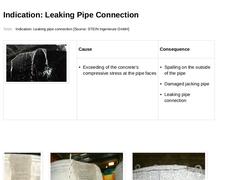
|

|
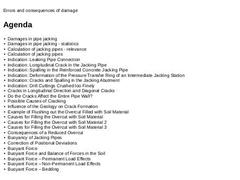
|

|
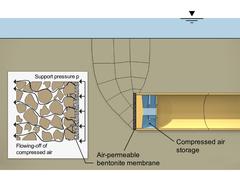
|

This presentation is part of the series of presentations "Utility Tunnelling" and deals with the various types of shield machines, the removal of obstacles and possible errors in pipe jacking. |
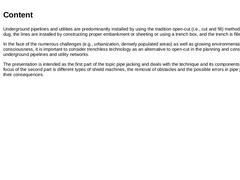
|

Underground pipelines and utilities are predominantly installed by using the tradition open-cut (i.e., cut and fill) method: a trench is dug, the lines are installed by constructing proper embankment or sheeting or using a trench box, and the trench is filled afterwards. In the face of the numerous challenges (e.g., urbanization, densely populated areas) as well as growing environmental consciousness, it is important to consider trenchless technology … |